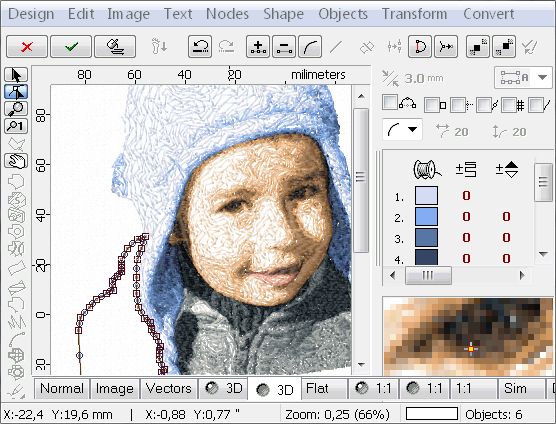Simplifying the Art of Embroidery Digitizing: Step-by-Step Overview
Embroidery digitizing is a careful craft that demands precision and imagination. As technology proceeds to development, the digitization procedure has actually become extra obtainable, enabling enthusiasts to bring their detailed layouts to life with ease. In this guide, we will unravel the intricacies of needlework digitizing, breaking down each step carefully to simplify the procedure and encourage both novices and experienced embroiderers alike. Keep tuned to find just how you can simplify this detailed art kind and transform your imaginative visions into perfectly embroidered work of arts.
Understanding Needlework Digitizing Software
Needlework digitizing software functions as a crucial device for transforming intricate styles right into digital formats compatible with needlework devices, promoting specific stitching and customization. This specific software allows individuals to import various picture documents layouts, such as JPG or PNG, and convert them right into embroidery machine-readable styles like DST, EXP, or PES - Digitizing for Embroidery. By using functions like stitch editing, rug options, and thread shade choice, digitizing software program enables individuals to regulate every facet of the design process
Additionally, progressed embroidery digitizing software program provides tools for producing intricate layouts, changing stitch density, and incorporating intricate details. Customers can also sneak peek the layout before stitching it out, making sure accuracy and decreasing errors. Additionally, numerous software application supply automatic features that aid improve the digitizing procedure, saving effort and time.
Recognizing the abilities of needlework digitizing software program is crucial for achieving high-grade lead to embroidery tasks. By understanding this device, embroidery fanatics and specialists can release their creative thinking and bring complex designs to life with accuracy and effectiveness.

Picking the Right Style Data
After familiarizing on your own with the capacities of embroidery digitizing software, the following essential action in the procedure is picking the right design apply for your job. Digitizing for Embroidery. When selecting a layout declare embroidery digitizing, it's important to take into consideration the intricacy of the layout, the dimension of the final product, and the kind of material you will be working with
For complex designs with great information, a high-resolution image or vector documents is recommended to guarantee that the embroidery machine can accurately replicate the style. In addition, the dimension of the final item plays a significant duty in picking the appropriate style documents. Larger layouts might require higher resolution data to preserve quality and sharpness.
Furthermore, the kind of material you will certainly be stitching on affects the option of layout file. Various helpful resources fabrics might require adjustments in the style data to ensure that the stitches are correctly lined up and the style looks like planned. By thoroughly picking the right design file based upon these variables, you can set yourself up for a successful embroidery digitizing process.
Digitizing Devices and Methods
Utilizing specialized software program and accuracy techniques, digitizing tools are essential in changing elaborate designs right into embroidery-ready data. Embroidery digitizing software, such as Wilcom, Hatch, or Embrilliance, offers the essential platform to convert artwork right into stitch data. These programs use functions like stitch editing and enhancing, padding choices, and lettering tools to ensure the design converts flawlessly onto fabric.
Among the essential strategies in digitizing is creating a clear course for the needlework maker to comply with. This includes digitizing each aspect of the design with precision, establishing stitch kinds, thickness, and directions. By using tools like digitizing tablets or software-specific plugins, embroiderers can attain a high level of accuracy in their digitized layouts.
Moreover, mastering the art of rug sewing is critical for creating top quality embroidery. Underlay stitching maintains the material and develops a structure for the design, ensuring that the final item is both aesthetically attractive and long-lasting. By understanding these digitizing devices and techniques, embroiderers over at this website can raise their craft and bring detailed designs to life with precision and performance.
Tailoring Stitch Kinds and Instructions
The option of stitch types can substantially impact the overall appearance and appearance of the stitched layout. By tactically combining these stitch types, embroiderers can attain deepness and dimension in their layouts.
Furthermore, the instructions of stitches plays a crucial duty in enhancing the aesthetic appeal of the final embroidery. Diverse stitch instructions can add structure, highlight details components, and develop aesthetic passion. Transforming the angle of stitches can imitate movement or all-natural patterns like fur or feathers. By trying out different stitch angles and patterns, embroiderers can bring their styles to life with impressive information and complexity. Understanding the art of personalizing stitch types and directions encourages embroiderers to unleash their imagination and boost the quality of their job.
Testing and Refining Your Digitized Layout
To make sure the accuracy and top quality of your digitized style, extensive testing and improvement are crucial action in the needlework digitizing process. As soon as you have actually completed the digitization of your design, it is important to evaluate it prior to continuing with the real needlework. Evaluating enables you to determine any prospective concerns such as thread breaks, stitch thickness issues, or design distortions that might affect the outcome.

After screening, it is essential to improve your digitized style based on the comments from the examination sew-out. This might include tweaking stitch settings, readjusting densities, or making modifications to the general design to achieve the preferred outcome. By site link iterating with testing and refinement, you can fine-tune your digitized style to excellence before moving onward with the actual embroidery procedure.
Final Thought
To conclude, understanding the art of embroidery digitizing needs an extensive understanding of the software, picking the ideal layout file, making use of digitizing tools and methods, customizing stitch kinds and instructions, and screening and fine-tuning the digitized design. By following these actions, embroiderers can simplify the digitizing procedure and create high-quality stitched styles with precision and effectiveness.
 Danny Tamberelli Then & Now!
Danny Tamberelli Then & Now! Jonathan Taylor Thomas Then & Now!
Jonathan Taylor Thomas Then & Now! Lark Voorhies Then & Now!
Lark Voorhies Then & Now! Michael Oliver Then & Now!
Michael Oliver Then & Now! Alisan Porter Then & Now!
Alisan Porter Then & Now!